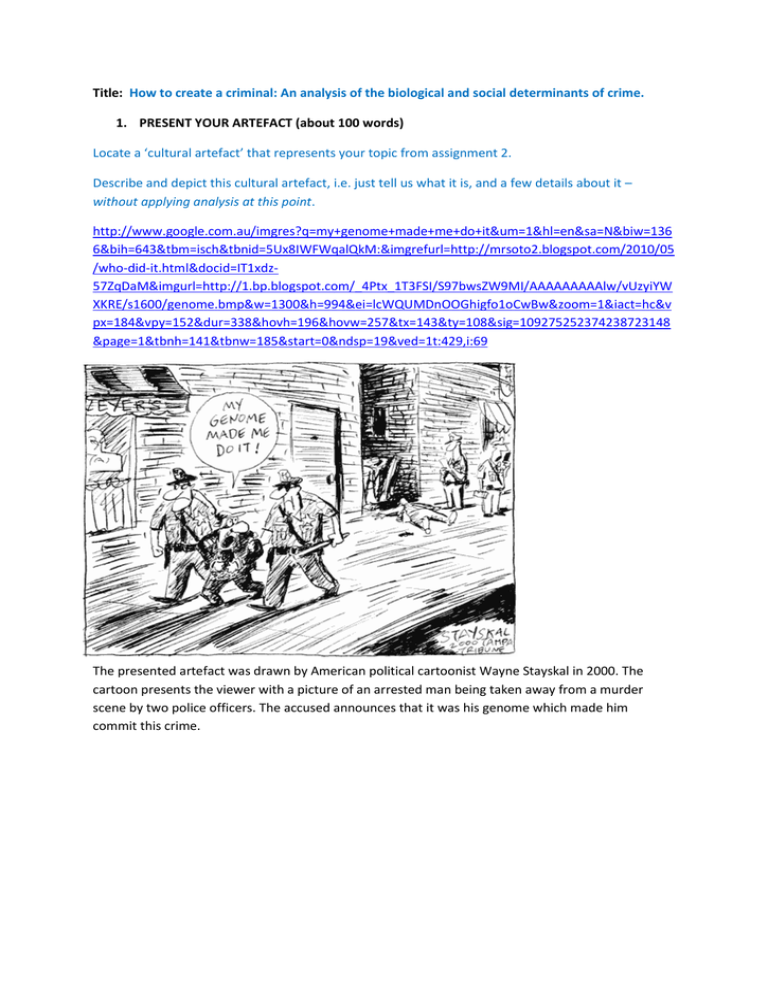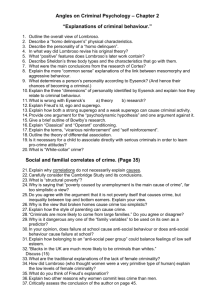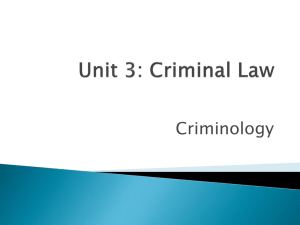Title: How to create a criminal: An analysis of the biological and
advertisement

Title: How to create a criminal: An analysis of the biological and social determinants of crime. 1. PRESENT YOUR ARTEFACT (about 100 words) Locate a ‘cultural artefact’ that represents your topic from assignment 2. Describe and depict this cultural artefact, i.e. just tell us what it is, and a few details about it – without applying analysis at this point. http://www.google.com.au/imgres?q=my+genome+made+me+do+it&um=1&hl=en&sa=N&biw=136 6&bih=643&tbm=isch&tbnid=5Ux8IWFWqalQkM:&imgrefurl=http://mrsoto2.blogspot.com/2010/05 /who-did-it.html&docid=IT1xdz57ZqDaM&imgurl=http://1.bp.blogspot.com/_4Ptx_1T3FSI/S97bwsZW9MI/AAAAAAAAAlw/vUzyiYW XKRE/s1600/genome.bmp&w=1300&h=994&ei=lcWQUMDnOOGhigfo1oCwBw&zoom=1&iact=hc&v px=184&vpy=152&dur=338&hovh=196&hovw=257&tx=143&ty=108&sig=109275252374238723148 &page=1&tbnh=141&tbnw=185&start=0&ndsp=19&ved=1t:429,i:69 The presented artefact was drawn by American political cartoonist Wayne Stayskal in 2000. The cartoon presents the viewer with a picture of an arrested man being taken away from a murder scene by two police officers. The accused announces that it was his genome which made him commit this crime. 2. NAME THE PUBLIC HEALTH ISSUE CENTRAL TO YOUR ANALYSIS (about 100 words) Identify and briefly describe the public health issue that this artefact represents (i.e., your topic, and the angles within that topic that you are focussing on) Are criminals born or socially constructed? The age-old debate of nature versus nurture discusses the extent to which particular aspects of behaviour are a product of genetically derived characteristics, or those which are learned and acquired over time. The consequences of crime have a profound, long-term impact on individuals and society (Ou & Reynolds, 2010). The controversial debate of nature versus nurture will be applied to this question through an analysis of the biological and social determinants of crime, in an attempt to address this issue of how criminals come to be. 3. LITERATURE REVIEW (750-1000 words) Conduct a literature review to demonstrate your knowledge of what the research/evidence says about your topic. What evidence can you provide to say that this is an important issue, and what have researchers and theorists being saying about this issue over the past 10 years? What methodologies are they using? What are the limitations of these methodologies in trying to fully understand and redress the issue? Reference corrects, in APA style, using high-quality, recent, peer-reviewed journal articles, and sources from the ABS, AIHW, etc. The abundance of information focusing on the issue of whether criminals are born or made continues to emerge. Over time, research has consistently questioned both sides of the nature versus nurture argument. When analysing the biological and genetic determinants of crime, one of the main areas of interest is the human brain. According to Ronald (2008), damage to the frontal lobes of the brain may majorly impact on an individual’s propensity towards engaging in criminal activity. The research of Seiden (2004) supports this idea, displaying a well-documented connection between criminal behaviour and brain dysfunction. The primary role of the frontal lobes is to mediate one’s higher level cognitive functions, involving the ability to plan, make judgements, and behave accordingly. A frontally damaged individual is more likely to commit criminal acts as the ability to judge situations and act appropriately has been compromised, in addition to the loss of ability to control abnormal impulses (Seiden, 2004). Raine (2008) summarises recent brain-imaging and molecular-genetic findings on antisocial, psychopathic and violent behaviour, discovering that specific genes result in structural and functional brain alterations, which will in turn, predispose to antisocial tendencies. Anti-social behaviour can be defined as a range of behaviours extending from socially unacceptable behaviours, for example swearing and bullying, to serious criminal acts such as physical assault and theft (Smart et al., 2004). Raine’s (2008) investigation further adds to other research, previously mentioned, with emphasis on the prefrontal cortex (area of the frontal lobes) associated with antisocial, hence criminal, behaviour. The above gives insight into the arguments towards criminals being genetically determined. However, it is highlighted that external influences may modify gene expression to activate the series of events involving the translation of genes into behaviour of an antisocial manner (Raine, 2008). Consequently, this leads us to the opposing side of the matter; the social determinants of crime – are criminals made? Numerous studies on social determinants have been extensively researched, with a focus on income, education, location and environment. Data from a 14-year longitudinal study was used to compare the age-crime curves of individuals in different neighbourhoods. It was concluded that compared with male youth in advantaged neighbourhoods, rate of violence among boys in disadvantaged neighbourhoods rose to higher levels, of which were sustained for a significantly longer period of time (Fabio et al., 2011). Hence suggesting that residing in a disadvantaged area during early adolescence may have an enduring effect on the shape of the age-crime curve throughout one’s life. Other studies investigating youth delinquency have found similar results when assessing disadvantaged neighbourhoods and cities. Weijters et al. (2009) found that the higher the level of absolute or relative deprivation in a city, the higher the extent of youth delinquency, emphasising the impact of which geographic location may play in the increased chances for youth delinquency to occur. Similarly to location comes the issue of environment, and the role this may play in contributing to criminal propensity. It has been found that property and violent crime rates are significantly higher and are directly affected in areas with environmental releases of lead, leading to high levels of air-lead pollution (Stretesky & Lynch, 2004; Mielke & Zahran, 2012). Already it is evident that external factors play a very prominent role in their ability to influence a person’s behaviour. Further contributing to the array of social determinants are the figures from the Australian Bureau of Statistics (2011), which indicate that seventy five per cent of people in custody have not completed year ten education. A study by Stephen et al. (2012) investigated the crime-education relationship. An expansion in a compulsory education system in the United Kingdom resulted in a decline in youth crime, revealing a significant relationship between crime levels and education. The lift in education also significantly impacted on other variables such as employment, leading to another focal point contributing to the argument for which criminals are made: socioeconomic status. An abundance of research points to the fact that criminal behaviour is strongly influenced by ones socioeconomic status. A study completed by Olivia & Parpucea (2011) aimed to elucidate a dependency between crime rate and socioeconomic conditions. Results show that there is a noticeable relation between high criminality and low income. Recent investigation also suggest that increased rates of crime are found amongst youth from socioeconomically disadvantaged families, with this increase in susceptibility to delinquency attributed to adverse family conditions and school and peer association (Fergusson et al., 2004). Likewise, Agnew et al. (2008) further supports the relationship between socioeconomic status and delinquency, stating that financial problems associated with a lower socioeconomic status, such as considerable lifestyle changes due to lack of money and the inability to be able to purchase necessary items, cause an inclination toward criminal behaviour. In spite of the great quantity of research consistently reporting on the biological and social determinants of crime, limitations of these employed methodologies exist. It is suggested by current research that social determinants predominantly influence criminal propensity, however limitations exist in the area of research regarding biological and genetic evidence. A restriction in the current technology and research methods available therefore results in a restriction in evidence presented. Advances in this area may have the potential to provide a more certain understanding of the biological factors in criminal behaviour. Nevertheless, research has undoubtedly established that both social and biological determinants contribute to the presence of criminal behaviour. 4. CULTURAL AND SOCIAL ANALYSIS (about 500 words) Use social theory, philosophy, and/or a research-based analysis of how and why society and culture are crucial to consider when trying to understand and redress this population health issue. Consider and discuss the groups, movements, and social change eras/trends, and cultural forces that both influence, and are affected by this issue. Who are the social and cultural groups who are most affected by this issue? Discuss why awareness of this issue is important, why we should discuss it, whether people are affected equally by it, and where public health experts should focus as a result of this analysis. The wider community is strongly affected by the consequences of criminal behaviour, not just the offenders alone. Prisoners in Australia experience profound inadequacies in health compared to the general public, having noticeably higher rates of chronic disease, mental illness, substance dependence and engagement in health risk behaviours (Butler et al., 2004; Australian Institute of Health and Welfare, 2011). Stuart et al. (2012) state that benefits gained by prisoners from contact with prison health services are often lost once they are released back into the community, making the health problems and concerns of prisoners an issue for the general population. Additional issues that result from criminal behaviour also impact on society, for instance, the criminal justice and social service expenditures result in lost tax revenue (Ou & Reynolds, 2010). Effective crime prevention and intervention are therefore imperative for the benefits of society, and identifying predictors of crime will aid in the development of these interventions (Ou & Reynolds, 2010). When identifying the predictors of crime (the social and biological determinants previously analysed in the above literature review) there are several issues to consider. Along with the fact that genetic advancements do not currently allow for great depth of evidence to be gained in the biological area, we take into consideration that social conditions and environments ultimately determine whether or not genetic predispositions are expressed (Najman et al., 2011). This leads to a focus on the social determinants of crime as the main area for prevention. Throughout the late 1800’s, Durkheim, a French sociologist, provided evidence that individual-level behaviour was significantly influenced by broader social processes and was primarily associated with social organisations (Henson, 2010), opposing popular theories of the time that explained biological theories to be the difference between criminals and non-criminals. This theory can be considered when addressing prevention of criminal behaviour. One major method of prevention is early intervention, and one in which public health experts may be able to focus on. Farrington (2002) discusses the benefits of early intervention in an ‘at risk’ child’s life, referring to a child who is categorised as having an inadequate education prospect, situated in a disadvantaged environmental and geographic location, and of a poorer socioeconomic status. It is noted that during childhood is a time which is exceedingly vital in one’s early developmental phase. Through implementation of early intervention, the cumulative nature of such risks is reduced and the collective nature of such protective factors is increased (Farrington, 2002). In both an individual and a communal sense, being aware of susceptibility to crime and external factors which may ‘trigger’ criminal behaviour is also imperative when addressing this issue. Ultimately, through identifying and targeting social determinants of criminal behaviour, and therefore decreasing rates of incarceration, research and awareness leads us to understand that this will in turn alleviate burden on society. MRI brain scan – frontal lobe highlighted Are criminals made? Émile Durkheim (1858-1917) 5. ANALYSIS OF THE ARTEFACT AND YOUR OWN LEARNING REFLECTIONS (about 250 words) Finally, go back to the artefact and tell us what it represents, how It is a good ‘case in point’ of your topic/issue, and what it means to you personally. Reflect on what you have learnt as a result of this assessment piece, and how, if at all, you think it will affect your future learning and thinking process. The artefact displayed symbolises the debate of nature versus nurture, representing the central focus of this wiki: the social and biological determinants of crime. Personally, upon finding this cartoon, it instantly provoked thoughts of whether or not one can use biological determinants as an excuse for antisocial and delinquent behaviour. Where is the line drawn when deciding whether or not someone committed a crime that they are not to be blamed for? However, due to the abundance of research previously mentioned that genetics are shaped by social factors, it is concluded that due to the role of nurture, and individual is responsible for their behaviour. There are two central themes that I have extracted from this learning experience. Firstly, although there are varying determinants contributing to crime, an awareness of these determinants leads to an increased capacity in the ability to prevent criminal behaviour, and decrease its burden on society. Secondly, through the analysis of the social and biological determinants of crime, I realise why the controversial debate of nature versus nurture is forever ongoing and why, unless a substantial amount of evidence is found supporting either argument, no absolute answer will be found in the near future. This assessment presented an ideal opportunity to develop skills in perceiving and examining complex issues. The importance of analysis from different perspectives has been revealed when drawing opinions or conclusions on topics of societal importance. REFERENCES: Agnew, R., Matthews, S, K., Bucher, J., Welcher, A, N., Keyes, C. (2008). Socioeconomic Status, Economic Problems, and Delinquency. Youth Society, 40(2), 159-181. Australian Bureau of Statistics. (2011). Prisoners in Australia, 2011 (Prisoner Characteristics, Australia), Report Number 4517.0 Retrieved from Australian Bureau of Statistics website http://www.abs.gov.au Australian Institute of Health and Welfare. (2011). The health of Australia’s prisoners 2010.Retrieved from Australian Institute of Health and Welfare website http://www.aihw.gov.au/publicationdetail/?id=10737420111&tab=2 Butler,T., Kariminia, A., Levy, M, & Murphy, M. (2004). The self-reported health status of prisoners in New South Wales. Australian and New Zealand Journal of Public Health, 28(4), 344–350. Fabio, A., Tu, L., Loeber, R., & Cohen, J. (2011). Neighborhood socioeconomic disadvantage and the shape of the age-crime curve. American Journal of Public Health, 101(S1) S325-32. Farrington, D. P. (2002). Developmental criminology and risk-focused prevention. The Oxford handbook of criminology, 3, 657-701. Fergusson, D., Swain-Campbell, N., Horwood, J. (2004). How does childhood economic disadvantage lead to crime? Journal of Child Psychology and Psychiatry, 45(5), 956-966. Henson, B. (2010). Durkheim, Émile: Anomie and suicide. In Encyclopedia of criminological theory. (pp. 279-281). Thousand Oaks, CA: SAGE Publications, Inc. Mielke, H. W., & Zahran, S. (2012). The urban rise and fall of air lead (Pb) and the latent surge and retreat of societal violence. Environment international, 43, 48-55. Najman, J., McGee, T.R., Wickes, R., Corcoran, J., & William, B. (2011). Antisocial behaviour: An examination of individual, family, and neighbourhood factors. Trends and Issues in Crime and Criminal Justice, 410, 1-6. Olivia, A. B., & Parpucea, I. (2011). Socio-economic factors impact on crime rate. Review of Economic Studies and Research Virgil Madgearu, 4(2), 5-20. Ou, S., & Reynolds, A, J., (2010). Childhood predictors of young adult male crime. Children and Youth Services, 32 (8), 1097–1107. Raine, A. (2008). From genes to brain to antisocial behavior. Current Directions in Psychological Science, 17(5), 323-328. Ronald, R. M. (2008). Brain dysfunctions associated with anti-social and violent behavior. Corrections Compendium, 33(5), 6-8, 10-11. Seiden, J. (2004). The Criminal Brain: Frontal Lobe Dysfunction Evidence in Capital Proceedings. Capital Defense Journal, 16(2) 395-401. Smart, D., Vassallo, S., Sanson, A., & Dussuyer, I. (2004). Patterns of antisocial behaviour from early to late adolescence (Vol. 290). Australian Institute of Criminology. Stephen, M., Olivier, M., & Sunčica, V. (2012). Youth crime and education expansion. German Economic Review, 13(4), 366-384. Stretesky, P. B., & Lynch, M. J. (2004). The relationship between lead and crime. Journal of Health and Social Behavior, 45(2), 214-29. Stuart, A. K., Streitberg, L., Butler, T., & Levy, M. (2012). Prisoner and ex-prisoner health: Improving access to primary care. Australian Family Physician, 41(7), 535-7. Weijters, G., Scheepers, P., Gerris, J. (2009). City and/or Neighbourhood Determinants? Studying Contextual Effects on Youth Delinquency. European Journal of Criminology, 6(5), 439-455.






